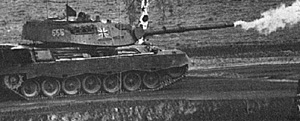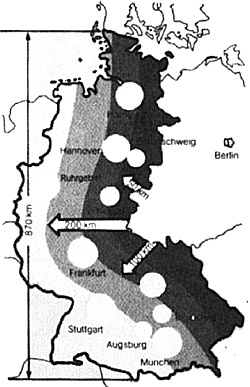 In order to prevent a Soviet invasion and takeover of Western
Europe, the North Atlantic Treaty Organization (NATO) was
established in 1949, presenting a "united" front against any
aggressive act. One of the cornerstones of NATO has been a
commitment to conventional front line defense in the Federal
Republic of Germany (FRG), commonly called West Germany.
In order to prevent a Soviet invasion and takeover of Western
Europe, the North Atlantic Treaty Organization (NATO) was
established in 1949, presenting a "united" front against any
aggressive act. One of the cornerstones of NATO has been a
commitment to conventional front line defense in the Federal
Republic of Germany (FRG), commonly called West Germany.
At various times, the politics of the United States turns a critical eye to the cost of and rationale for keeping American soldiers on that front line in Germany. Opponents of this continental strategy give the impression that the U.S. pays the lion's share of that cost and bears the greatest risks, while the Western European Allies shirk their responsibilities.
 That is incorrect.
That is incorrect.
In fact, the West Germans themselves carry the major burden of the cost and the risk. They pay over 25% of the costs, just slightly less than the United States. They provide 60% of the main battle tanks (some 4,900), 50% of the troops, and 30% of the aircraft. The reason is simple. Their existence as a nation is directly on the firing line.
Geography is against them. The FRG packs 62,000,000 people into a country the size of the states of New York and Pennsylvania. Its population density of 274 people per square kilometer is TEN TIMES higher than the United States' and is one of the highest in Western Europe. Agricultural land takes up 54% of the available area; forests account for 29%.
The rest is built up and urbanized. The FRG is laced with over 340,000 miles of roads, including some 5600 miles of expressway. It is extremely vulnerable to a western thrust by the Warsaw Pact. As shown in Figure 1, it has some 1260 miles of borders with Soviet Bloc nations, but is very narrow - only 158 miles at its widest. Some 30% of the FRG's population and 25% of its industrial capacity is located within 70 miles of the East-West border.
What does this mean in military terms? Warsaw Pact aircraft can reach any point in the FRG within 10 minutes. Major urbanindustrial centers, like Hamburg, are a few hours' drive for a tank from the border.
With nearly two-thirds of the Soviet military strength located in the European portion of the Soviet Union or in the western forward area, the simple strategic fact is that the West Germans can't afford to lose territory. So they are committed to the NATO Alliance and to forward defense with a dedication that even the United States can't match.
More Bundeswehr Mission, Organization, and Doctrine
Back to Table of Contents: CounterAttack #1
To CounterAttack List of Issues
To MagWeb Master Magazine List
© Copyright 1987 by Pacific Rim Publishing Company.
This article appears in MagWeb (Magazine Web) on the Internet World Wide Web.
Other military history articles and gaming articles are available at http://www.magweb.com